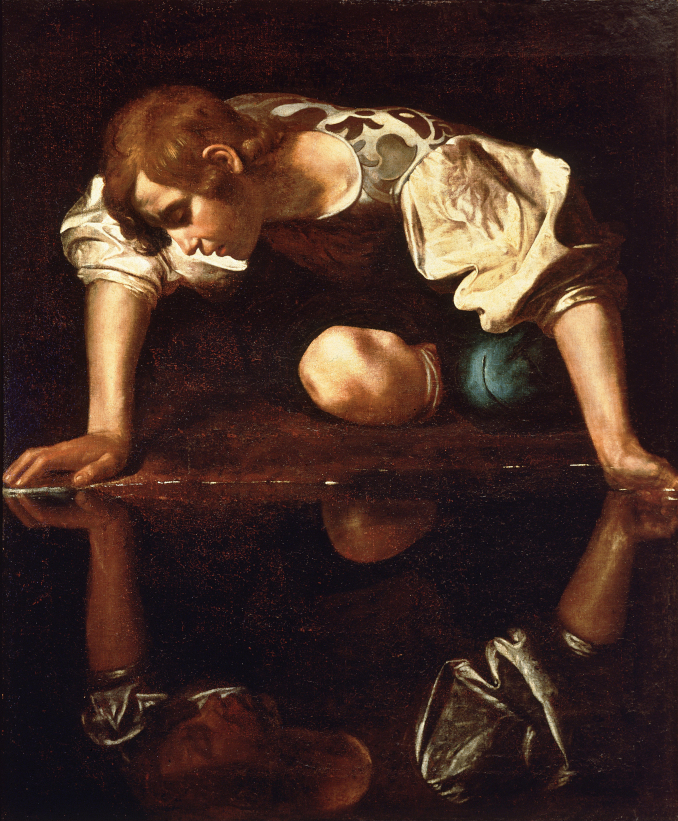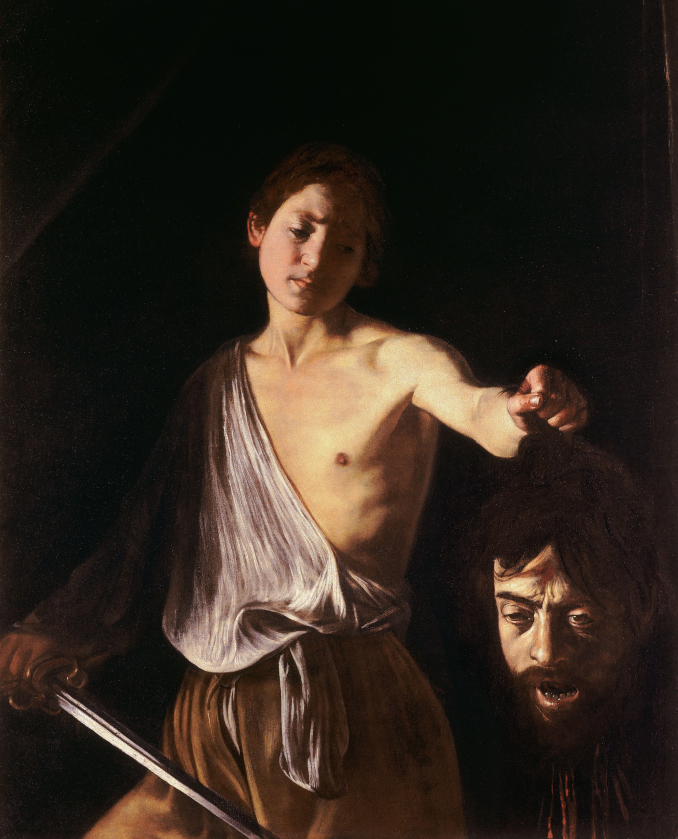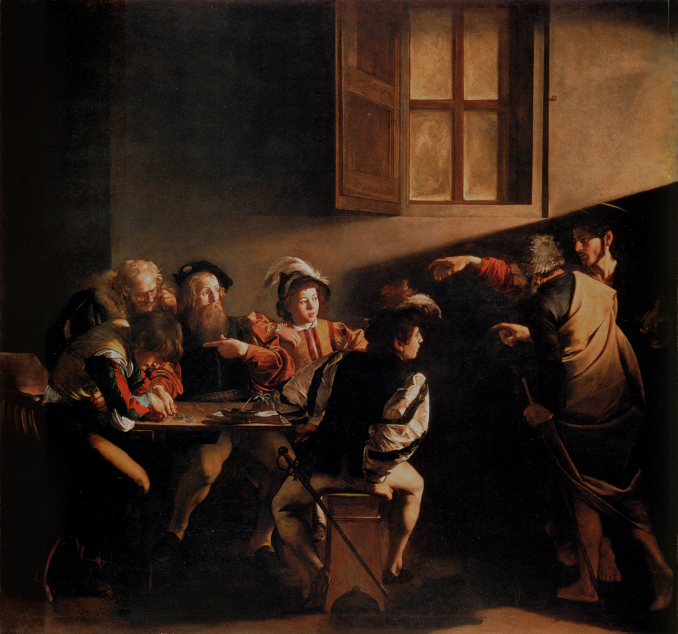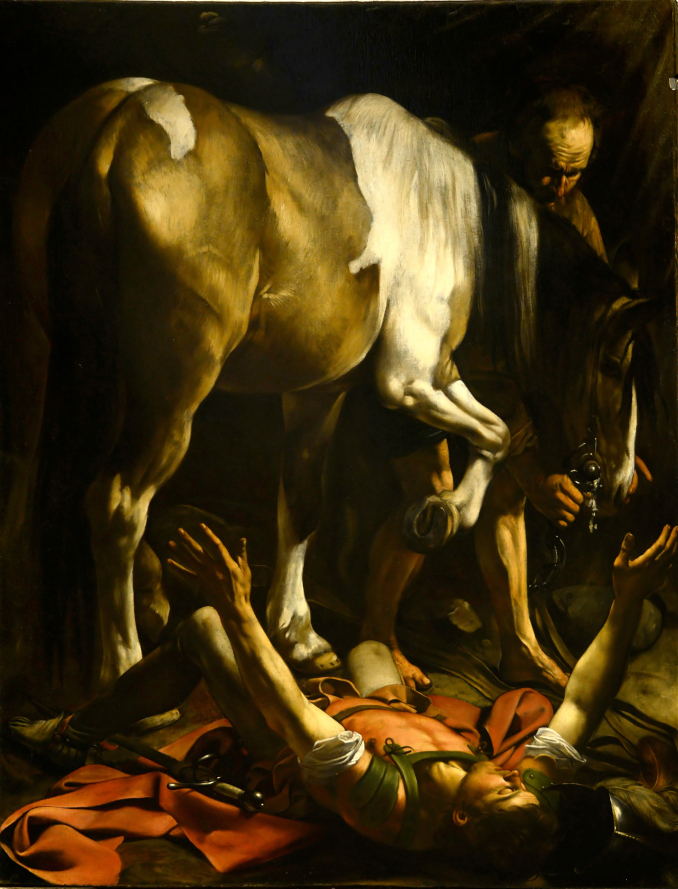Food for the Soul: Caravaggio in Rome


Caravaggio. Narcissus. Ca. 1599. Galleria Nazionale d’Arte Antica di Palazzo Barbierini.
Photo credit: Wikimedia Commons. Public Domain.
“There was art before him and art after him, and they were not the same.”
Robert Hughes, late Australian art critic on Caravaggio
By Nina Heyn- Your Culture Scout
There are several ways to enjoy art in Rome. One is the not-so-enjoyable run through major attractions in the sweltering heat of the travertine tiles (“let’s see if we can squeeze the Sistine Chapel after the Pantheon”), the other way is a leisurely exploration of Rome’s incredible art museums but then who has the time and energy to check them all out. Another way might be to concentrate on a single theme, and one of the most rewarding artists who can be admired on tourist walks through Rome is Michelangelo Marisi, also known as Caravaggio. Much has been said about his tragic life (bouts of malaria, constant violent brawls with one of them ending in a murder, his peregrinations in the Mediterranean trying to escape pursuit) and even after his passing, his art has had its ups and downs. There was a period when his paintings were shunned, whereas now his art valuation is reaching the heights of Rubens, Rembrandt and other old masters.
As a matter of fact, there is a painting Judith Beheading Holofernes that was literally found under a mattresss in a French attic, and which has just been sold to mysterious buyer for $170 million while not being even fully authenticated (not to mention a mysterious lifting an export license by the French state). It certainly looks like a Caravaggio but he created his famous doubles (similar paintings painted twice) and there are some excellent old copies (e.g. San Francis in Meditation – the authenticated original is in Roman Palazzo Barbierini, and a copy by a follower is in the Roman church of Santa Maria della Concezione) so this artwork will probably remain a mystery even if publicly displayed. Besides, there are enough moving and beautiful Caravaggio paintings throughout Rome’s museums and churches to give insight into his art without seeking controversial ones.

Caravaggio. David with the Head of Goliath. 1609-10. Displayed at Galleria Borghese.
Picture credit: Wikimedia Commons, public domain.
The artist had a hard-scrabble life. He would paint feverishly to satisfy commissions, to win favor of his patrons, or to gain a pardon of cardinals and popes to save his skin. One of the most moving and dramatic paintings at the prime Roman art museum Galleria Borghese is David with the Head of Goliath. David’s expression is not triumphant. He casts a sad, compassionate look at a head of Goliath whose face is a Carvaggio’s self-portrait. This painting is known as a plea for pardon to Cardinal Scipione Borghese to repeal a death sentence meted out to him after he killed a noble Ranuccio Tomassoni in a drunken brawl. Cardinal Borghese was a famous nephew of Pope Paul V (who continued a long tradition of Italian church officials granting favors to their family – a practice that gave birth to the term of “nepotism”). Borghese was a ruthless art collector who would not hesitate to plead, borrow, steal, misappropriate or blackmail an artist into creating masterpieces for his trove of artworks. This painting was a plea to Paul V to grant clemency while Caravaggio was hiding in Naples in 1609. Borghese was such a fan of Caravaggio’s paintings that he also acquired a couple of versions of a Boy with a Basket of Fruit from Cavalier D’Arpino (who has been jailed for debts and released when he “gifted” his collection including the paintings), and a controversial but genius rendition of Madonna and Child. So called Madonna dei Palafrenieri was ostensibly a church decoration commissioned for an altar within the St. Peters Basilica in the Vatican, but after being displayed there for a mere few days, it was deemed not appropriate, moved to a nearby church of St Anne, and then quietly purchased for a small sum by Borghese. Contemporary historians consider this mysterious change of ownership a ploy that the Cardinal had come up with to obtain the painting.
In Rome some exquisite Caravaggios are to be found in churches rather than museums and it is more fun to see them in their natural settings. In fact, his pictures in churches are easier to view than the ones in the museums. The lighting is much better even if you have to pay couple of euros to switch on the spotlight. Roman museums tend to have a strange combination of bad natural light and harsh spotlights that reflect off the varnish – making it often almost impossible to see anything of value.
The church of San Luigi dei Francesi is famous for its Contarelli Chapel – a nave with three Caravaggio paintings that illustrate scenes from the life of St. Matthew. These were the artist’s first public commissions in Rome, and they are prime examples of his innovation of focusing strong light on the parts he wanted to show and the confident ignoring of the rest of the composition. He painted Martyrdom first, an action scene where a naked and muscled assassin is about to strike St. Matthew with people around him fleeing or recoiling (including Caravaggio himself whose sad face is in the background). The center painting is a second version of St. Matthew and the Angel (the first one was rejected for not having “enough decorum”) – a red-clad St. Matthew is writing and turning towards an angel who enumerates on his fingers the points that need to be written down. And, finally, the left panel is The Calling of St. Matthew. A young, handsome Christ points at Matthew and his companions in a gesture that quotes the hand of God in Michelangelo’s creation of Adam. Matthew and St. Peter both respond with the same incredulous hand gesture “do you really mean that?” It is a complex composition of overlapping figures, of light and shadow interplay, and colors and fabrics emerging from the darkness enough to make an impression when light strikes them.

Caravaggio. The Calling of Saint Matthew 1599-1600. Church of San Luigi dei Francesi. Rome.
Photo credit: Wikimedia Commons.
A nearby church of St. Agostino has the famous Madonna of Loreto – with St. Mary holding an infant Jesus and looking down at pilgrims kneeling in front of her. The painting caused some scandal since the face of the Madonna is most likely that of the artist’s girlfriend, and the peasants’ dirty feet and messy clothes was not the way you portrayed anybody on church altars. The famous 13th c. Basilica of Santa Maria del Popolo is decorated with two complex “action scenes” from the lives of saints: The Conversion of St. Paul – a dramatic painting dominated by a horse avoiding stepping down on fallen St. Paul, and The Crucifixion of Saint Peter– a striking image of St. Peter being lifted upside down onto a cross. Both paintings have a complex distribution of light and a masterful rendition of bodies in unusual positions. Both are also artists’ deep meditations on martyrdom and spirituality.

Caravaggio. Conversion of St Paul. 1604-05. Rome, Santa Maria del Popolo.
Photo credit: Wikimedia Commons. By Alvesgaspar – Own work, CC BY-SA 4.0
Much has been said about Caravaggio introducing realism into art which in his times tended to be either exaggerated or just the opposite – classicizing. However, even if his incredibly realistic renderings of plants and fruit are an attempt to deceive the eye that the grapes are ready to pluck and peaches are ready to sprout juice, his representations of people are anything but realistic. His numerous John the Baptists are simply gorgeous youths, mostly naked or scantily clad in strategically placed wisps of sumptuous silk. His Madonnas have faces of his girlfriends and prostitutes who posed for him, but their poses and context (like the symbolic crushing of the Evil in a form of a snake) are anything but realistic. His backgrounds are the least realistic of all – there are no gentle landscapes in the da Vinci style, no views of Roman cities like in Rafael’s frescoes. It is one of the reasons Caravaggio has influenced so many artists – not only soon after his passing (Rubens, La Tour or Rembrandt) but all the way through Delacroix or Courbet to modern art. Caravaggio is definitely a precursor of modern paintings – his compositions have backgrounds that are all black or just some flat color, and what is presented through the lighting or color are just fragments of a person’s body or clothing. It’s the shadow and light, and color or its absence that count, not the realistic rendition of every person. He selects, and by doing this he shows a path towards modern art. His masterful Narcissus is a perfect example – we see his knee emerging from darkness like a ball of light, and his reflected arms create a circle of colors and shapes. There is a story to this charming picture but there is also a perfect play of colors worthy of any abstract artist who came after.
Between Roman art museums, the city’s baroque churches and the Vatican, twenty three out of sixty Caravaggio paintings can be found in the Eternal City. The most fun is to admire them in context – in gorgeous Roman churches, with light streaming through stained glass and in the cool air of very old stones.
Check It Out!
